Artist Pro 19 (Gen 2) Drawing Display
Content
Introduction
Product Settings
FAQ
1.Product Overview

1.Indicator Light
1.1 Press the power button to turn it on. The blue light will remain steady. Press the power button again to turn it off.
1.2 Standby mode, steady orange.
1.3 In Drawing Tablet mode, long press the power button for 3 seconds. The blue light and orange light will flash alternately. Press the power button again to return to regular mode.
2.Power Key
3.Brightness Up / Down
4.Full-featured USB-C Port *2
5.Display/Work Area
6.Wrist Rest
7.Foldable Stand
8.Extendable VESA Bracket Installation Holes (75*75mm)
9.Silicone Antislip Pad
10.Ventilation Holes
2.Accessories
-H11 Pen Case *1
Built -in:
X3 Pro Roller Stylus *1
X3 Pro Slim Stylus *1
Bluetooth Receiver for Wireless Shortcut Remote *1
Replaceable Button Cap for Slim Stylus *1
Standard Nib for Slim Stylus *4
Standard Nib for Roller Stylus *2
Felt Nib for Roller Stylus *2
Nib Extractor *1
-3in1 Cable *1
-USB-C to USB-C Cable *2
-USB-C to USB-A Cable *1
-PD Power Adapter *1
-Wireless Shortcut Remote ACK05 *1
-Drawing Glove*1
-Cleaning Cloth *1
-Pen Nibs Bag *1
Built -in:
Standard Nib for Slim Stylus *5
Standard Nib for Roller Stylus *5
Felt Nib for Roller Stylus *5
3.Connection
3.1 USB-C Connection
Connect drawing display to the computer via the USB-C to USB-C cable. If the drawing display does not light up, please connect the drawing display to the power adapter via another USB-C to USB-C cable.

3.2 3in1 Connection
3.2.1 Connect to the computer via 3in1 cable
Use the 3in1 cable, connect the drawing display to the computer via the HDMI and the USB-A ports.
3.2.2 Connect to the power supply via USB-C to USB-C cable
Option 1: Use the USB-C to USB-C cable to connect the USB-C power port of the 3in1 cable and the PD power adapter.
Option 2: Use the USB-C to USB-C cable to connect the other USB-C port of the drawing display and the PD power adapter.
* If your computer has multiple HDMI/DP interfaces, please connect to the interface of the independent graphics card.

3.3 Android Device Connection
3.3.1 Connect the drawing display to your Android device directly via the USB-C to USB-C Cable.
3.3.2 Connect the drawing display to the power adapter via another USB-C to USB-C cable.
* Please check the XPPen official website for compatible Android phone/tablet models.

4.Wireless Shortcut Remote Connection
4.1 Wired Connection
Connect Wireless Shortcut Remote to your Computer via USB-C to USB-A Cable.

4.2 the Bluetooth receiver Connection
Plug the Bluetooth receiver into the computer and slide the power switch. The indicator light should always be blue. The blue indicator will be off after 30 seconds.

4.3 Direct Bluetooth connection
4.3.1 Slide the power switch and the blue indicator light flashes slowly. Then long press the K11 shortcut key for 6 seconds to enter Bluetooth pairing and the blue indicator light flashes quickly.
4.3.2 Turn on the Bluetooth on the computer, add Bluetooth device, search for Shortcut Remote and complete Bluetooth pairing by clicking the device name, with the blue indicator always on. The indicator will be off after 30 seconds.
4.3.3 Slide the power switch again to turn it off.

5.Compatibility
Windows 7 (or later)
macOS 10.13 (or later)
ChromeOS 88 (or later)
Android (USB3.1 DP1.2)
Linux
1.Driver Download
1.1 Make sure your drawing display is connected correctly to the computer.
1.2 Visit the XPPen website (www.xp-pen.com), click on the Support section and then Download. Choose a product mode and download the latest driver according to your computer system.
1.3 Follow the prompts to finish the driver installation.
Note:
a) Before installation, please close all anti-virus software and graphics software.
b) If the computer has already installed the drivers of other brands, please uninstall them first.
c) Please restart your computer after the installation is complete.
d) For the best performance of your device, it is recommended that you use the latest version of the driver.
2.Driver Installation
2.1 Windows
Unzip file. Run the "exe" file as administrator, and follow the prompts to complete the installation.
2.2 Mac
Unzip the file, run the "dmg" file, and follow the prompts to complete the installation. Go to System Settings -> Privacy & Security -> Accessibilities (Wireless: System Settings -> Privacy & Security -> Accessibilities & Bluetooth), please ensure that the PenTabletDriver option is checked; Otherwise, the device and driver may not function properly.

If there is no PenTablet_Driver on the list, go to resource Library -> Application Support -> PenDriver to add the driver manually.

2.3 Linux
Deb: Enter command “sudo dpkg -i”. Drag the installation file to the window and execute the command;
Rpm: Enter command “sudo rpm -i”. Drag the installation file to the window and execute the command;
Tag.gz: Unzip file. Enter command “sudo”. Drag “install.sh” to the window and execute command.
3.Driver Instructions
3.1 Device connection
If the device is not connected or the connection fails, you can see the following prompt. In this case, try to restart your computer or the driver, or contact our service staff for support.

If the device is connected to your computer successfully, the device name will be displayed in the upper left corner of the driver.

3.2 Device Switching
You can connect multiple devices via the driver at the same time. Customize a specific device's settings after switching to that device, and all changes made will only apply to that device.

3.3 Driver Settings
By clicking the icons on the left, you can switch the driver functions. From top to bottom, they are device settings, pen settings, and driver settings. Clicking the restore default button in the upper right corner will restore the device to default settings.

3.3.1 Drawing Display Settings
a) Calibration
Hold the stylus in your usual way and click the center of the red cross on the monitor to calibrate the offset between the stylus and the cursor.
b) Work area
Define the mapping between the device's work area and the screen display area.
Screen

You can set the mapping between the display area of the current monitor and the device.
If multiple monitors are used in duplicate mode, the work area of the device will be mapped to all monitors. When the pen moves in the work area, the cursor on all monitors will move at the same time.
If multiple monitors are used in extend mode, go to monitor tabs to select one of the monitors that the work area of the device will be mapped to.
Set the monitor mapping area:
1.Set full screen: The whole area of the selected monitor;
2.Customize screen area:

Drag to select an area: Drag the cursor from one point to another on the Screen.
Click to set screen area: Click the upper left corner position and lower right corner position to select on the monitor.
Coordinates: Manually enter coordinates in the corresponding input boxes for X, Y, W and H.
Identify:
Identify all connected monitors. The numeric identifier will be displayed in the lower left corner of each monitor.
Pen Display

Set the work area of the device:
1.Full area: The whole work area of the device is available.
2.Customize active area:

Drag to select an area: Drag the cursor from one point to another on the device.
Click to set active area: Use stylus to click the upper left corner position and lower right corner position on your device.
Coordinates: Manually enter coordinates in the corresponding input boxes for X, Y, W and H.
3.Proportion: Scale your device's work area and selected display area proportionately.
For example: After selecting proportion, if you draw a circle on the device, a circle will appear on the screen, but some part of the work area may not be used. But if you don’t choose the proportion and draw a circle, then the circle may change into an ellipse on the screen.
Rotation:
You can set the device to 0°, 90°, 180° and 270° clockwise for use.
Left-handed mode: Rotate 180°.
a) Display settings

Brightness, Contrast: Slide the corresponding slider to adjust the brightness and contrast.
Color space: This product has preset three color modes: sRGB, Adobe RGB and P3. Accurate and strict color gamut limits and calibration have been applied to all modes. You can use it directly without the ICC limit again.
If you want to configure ICC manually, you can select USER mode in the display setting option under the driver interface, and configure it under native color.
In the USER mode, the color space can be customized by adjusting the color temperature (the values of R, G, and B can also be adjusted when selecting USER mode in the color temperature).

Color temperature: The driver enables five modes, 5000K (low blue light), 6500K (default), 7500K, 9300K, and USER.

Low Blue Light: Enable the low blue light mode to prevent eye fatigue and make your eyes more comfortable. When the low blue light mode is turned on, the screen may display a yellowish tint, which is a normal occurrence. The product comes with a built-in low blue light protection mode, allowing you to choose between low blue light protection or other color temperature settings to enable or disable this mode.
3.3.2 Pen settings
When the stylus is within the work area, the device will recognize the stylus and add it to the driver. The stylus used should be compatible with the device.
a) Pen Switching
You can click the pen name drop-down menu on the right and select the corresponding stylus to set. When you use the corresponding stylus, the driver will automatically switch to the custom settings of the pen.

b) Pen Keys
Click on the pen keys position on the image to customize its function.
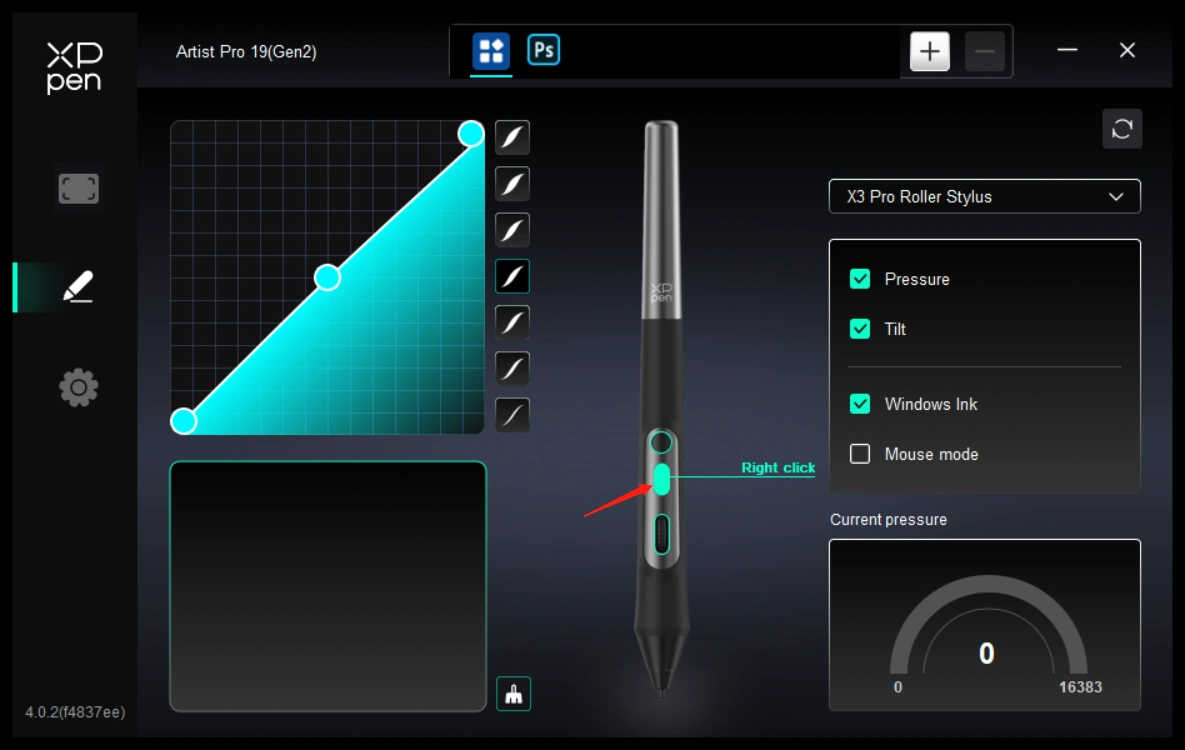
Keyboard:
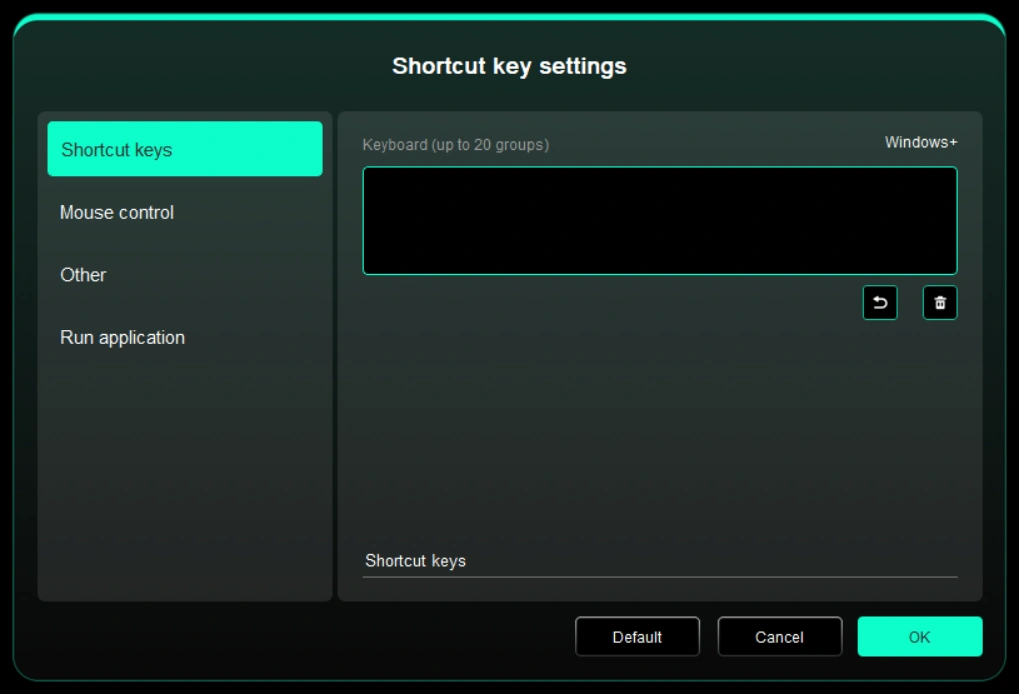
You can set a keyboard shortcut, e.g. "Alt+A" in 3D MAX, so that the alignment tool can be used.
Multiple groups of shortcut keys can be set. For example, type Ctrl+C, Ctrl+V, and when you press the key, the shortcut key functions set will all run once.
Windows (Command): You can add a combination key containing system key, for example: to enter Win (Cmd)+Shift+3, you can press Shift+3 and the driver will bring the system key automatically.
Customized name:
You can customize the name of the current settings.
Mouse Control:
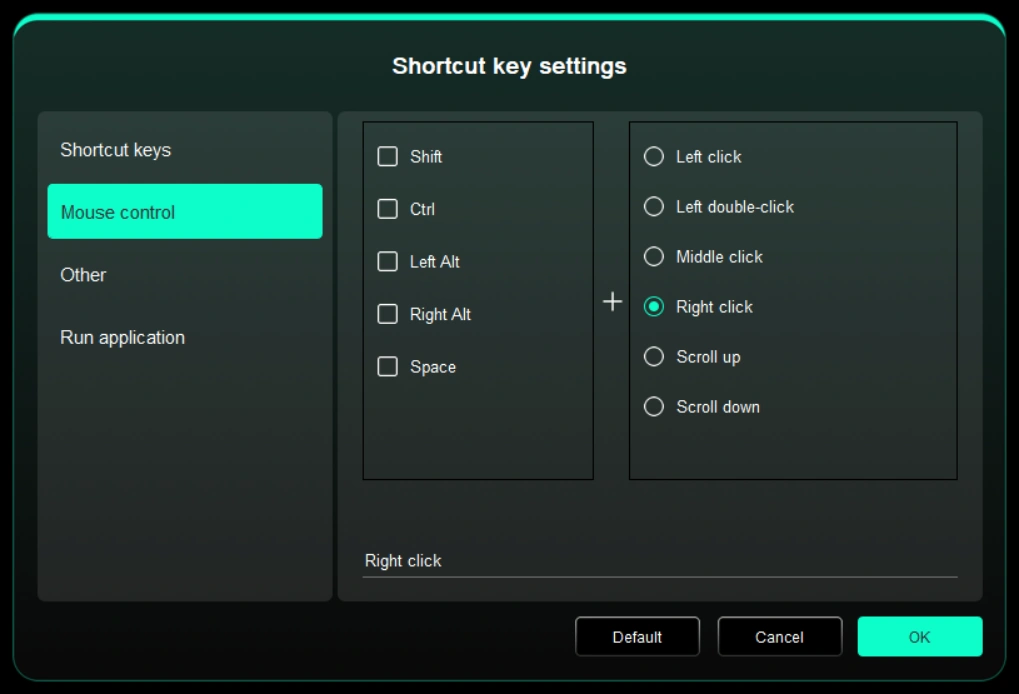
Set the key combination of mouse and keyboard. With the "Shift" and "Left Click" selected, the shortcut actions can be enabled in application that supports such key combinations.
Other-Precision mode:

Show driver panel: quickly display the driver settings panel
Switch monitor: when there are multiple display devices, you can map the cursor to other display devices.
Precision mode: limit the active area of the screen to a certain range, and make more detailed drawings for the area.
Scroll: after pressing the corresponding button, you can use the pen to realize the scrolling function
Run application:
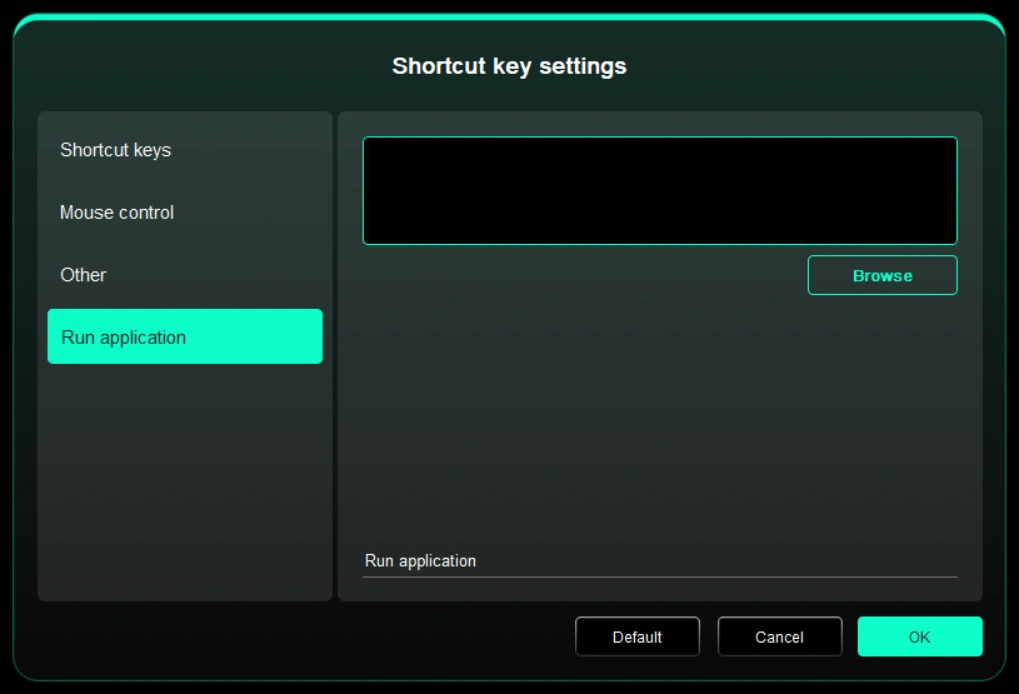
Quickly launch the corresponding application through shortcut keys
Pen roller settings:
Click the roller button on the roller pen on the driver to set the corresponding function and speed of the wheel.
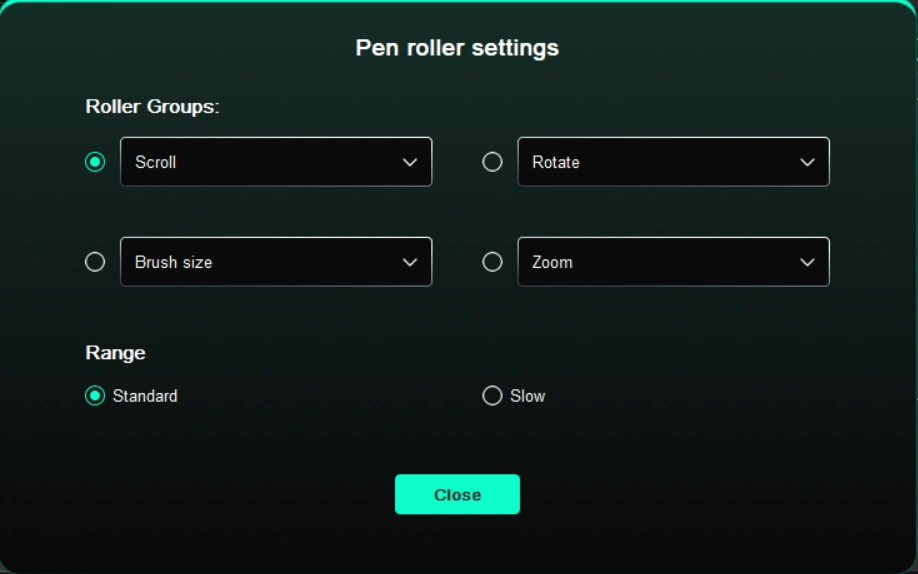
c) Pressure
By adjusting the pressure curve or selecting preset pressure options.
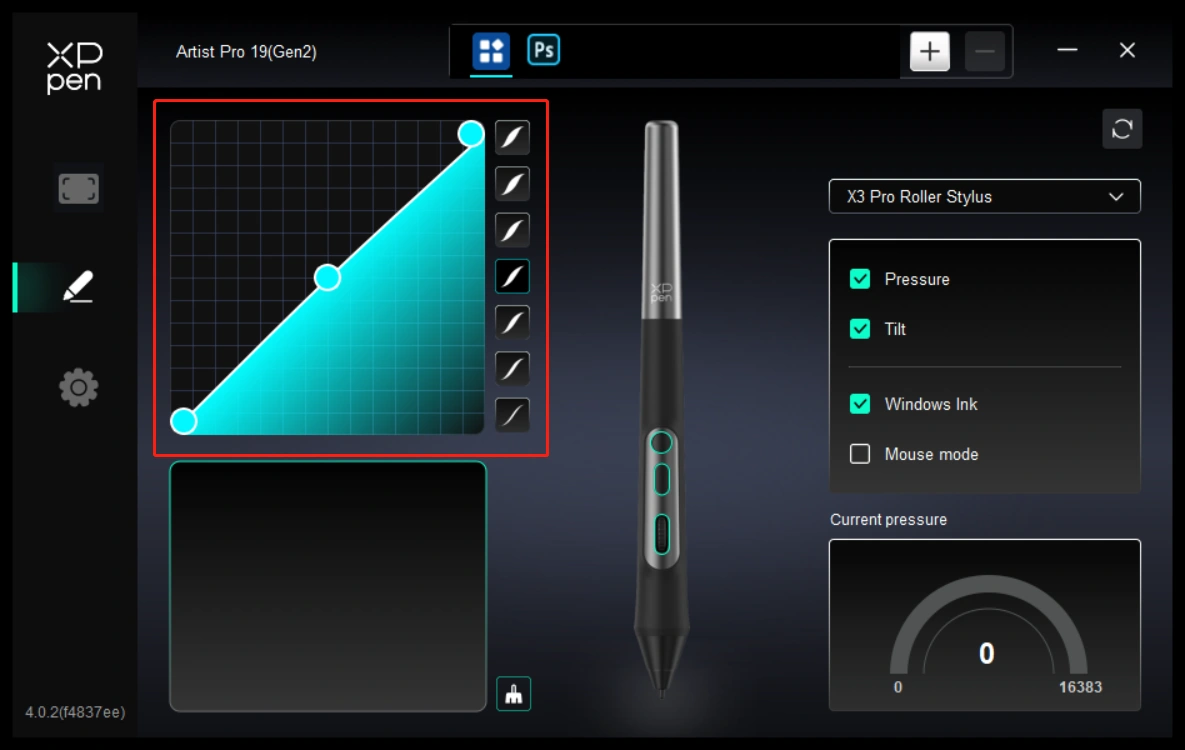
Current pressure:
Test the current pressure.
Pressure:
If closed, you will not feel the pressure when using the stylus.
Tilt:
If closed, the tilt effect of the pen is turned off.
d)Others
Mouse mode:
When you move your pen out of the work area, the cursor will stay where you leave, which is like operating a mouse. Select the mode and you can adjust the speed of the cursor on your device. If you do not select the mode, the pen mode is default.
Windows Ink (for Windows only):
Windows supports handwriting function. If you need to use this function in Microsoft Office/Whiteboard or other software, please do not turn it off.
Tilt:
If closed, the tilt effect of the pen is turned off.
3.3.3 Applications
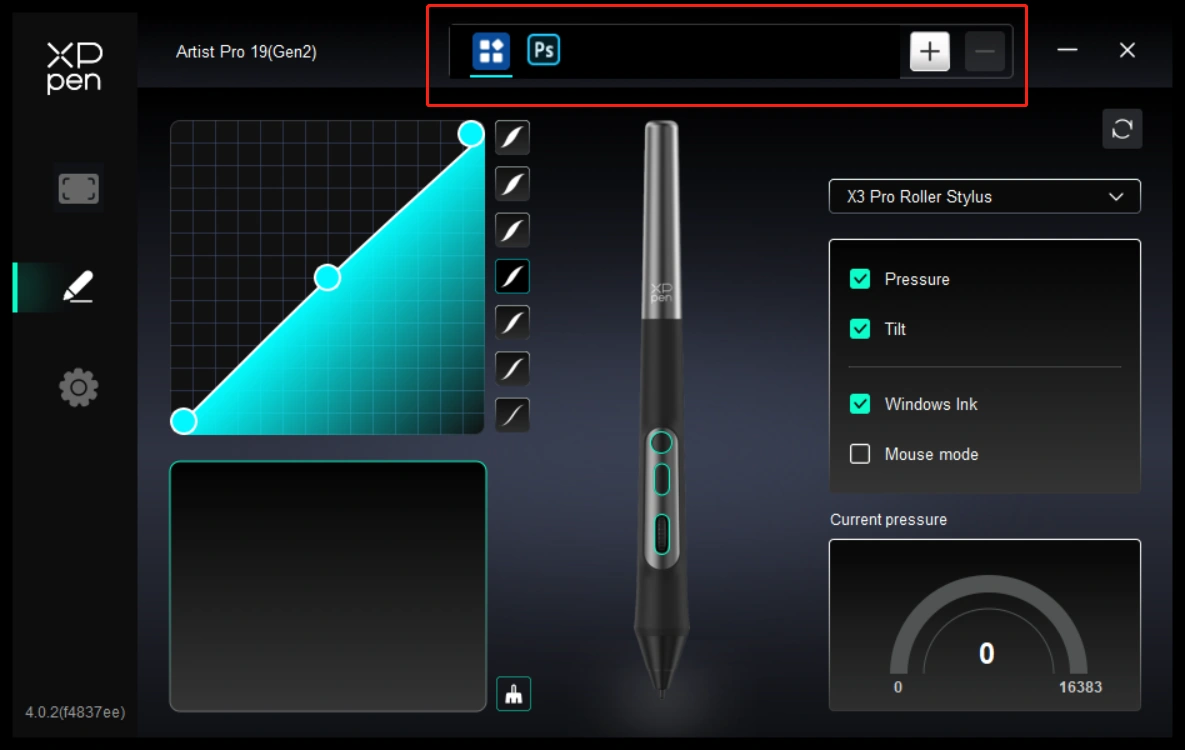
Add an application from the list of applications, tick the application, and then customize pen key functions.
For example, if you select an application and change its configuration, the change is valid only when you use the application. When you switch to another application, the driver will recognize it automatically. You can add up to 7 applications.
1.Click the + icon on the top right of the application bar to open the application list;
2.Select an application to be added from the running applications or click Browse to add from the installed applications;
3.Click "OK" to add the selected application;
1.Select an added application, and click the - icon on the top right of the application bar to delete the application.
If you select all other applications, it will apply to other uncustomed applications.
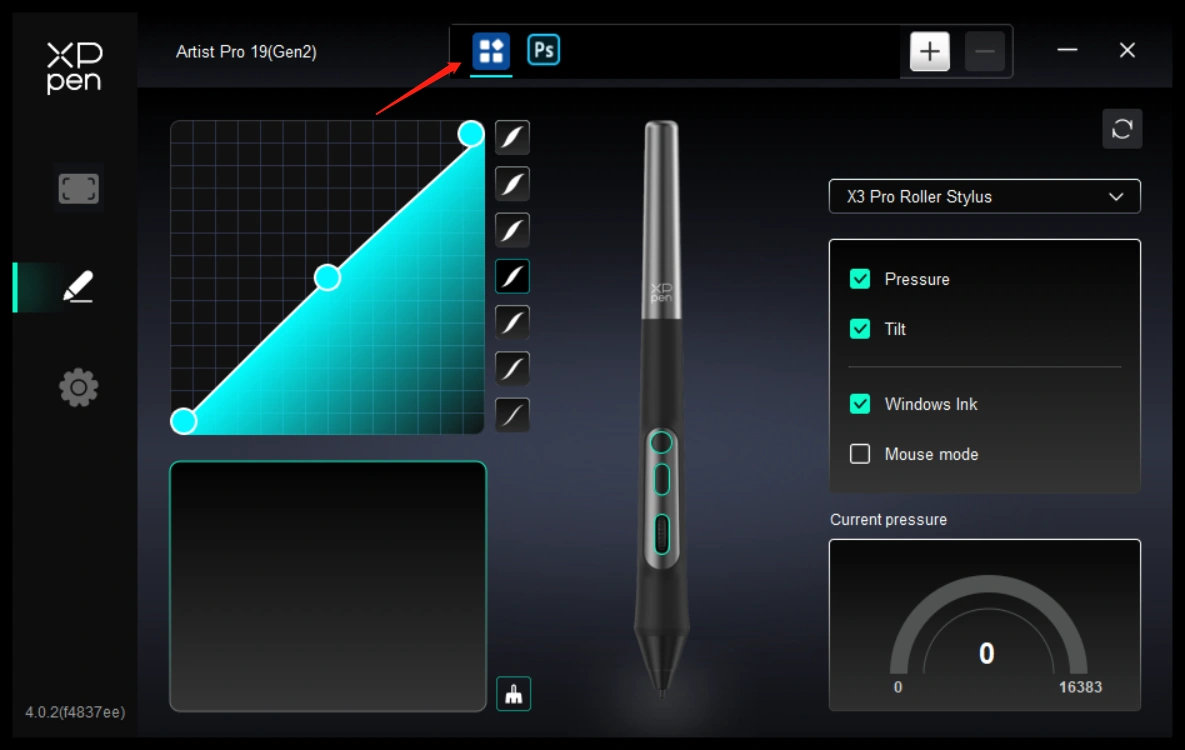
3.3.4 Settings
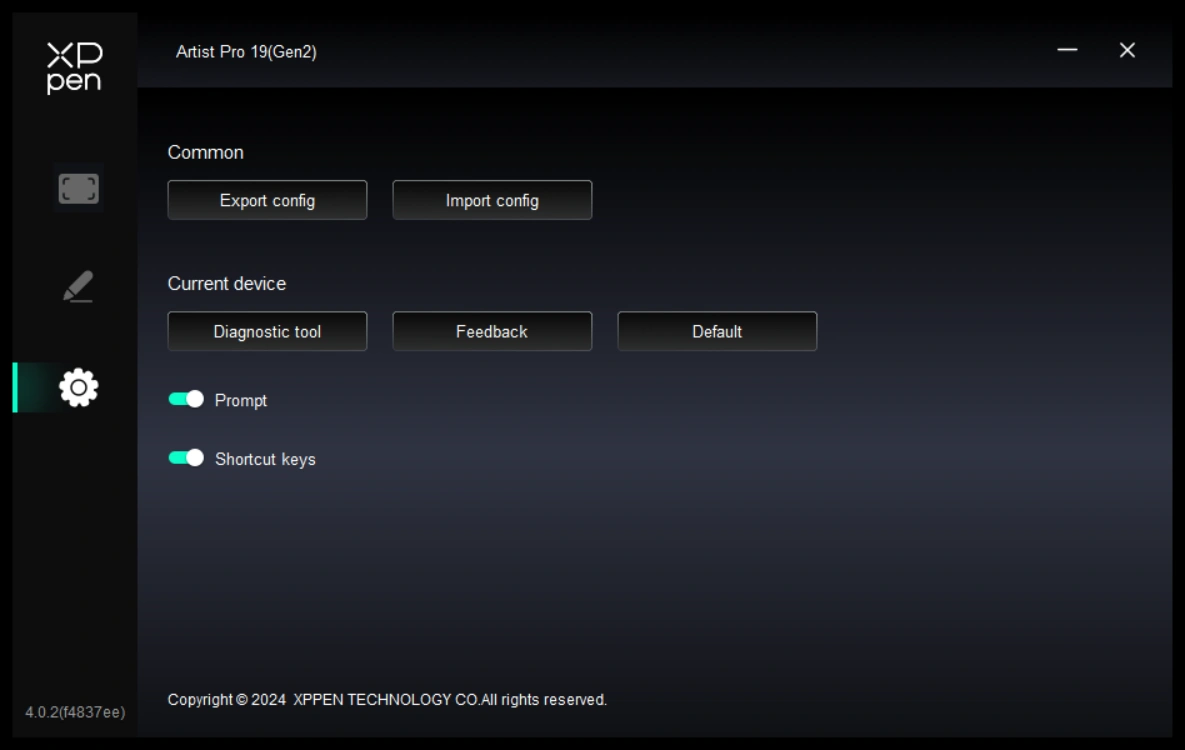
Import & Export config:
You can import/export configurations to read or save settings.
This function is only available for the same operating system.
Shortcut keys:
If closed, disable the functions of all keys of the device.
Prompt:
If closed, when you press a key, no key prompt will be displayed at the bottom of the screen.
Diagnostic tool:
You can use the diagnostic tool in case of any problems while using the driver
Feedback:
If you have any questions or suggestions during the use of the driver, you can give us feedback through this page.
3.3.5 Shortcut Remote Setting
a) Applications
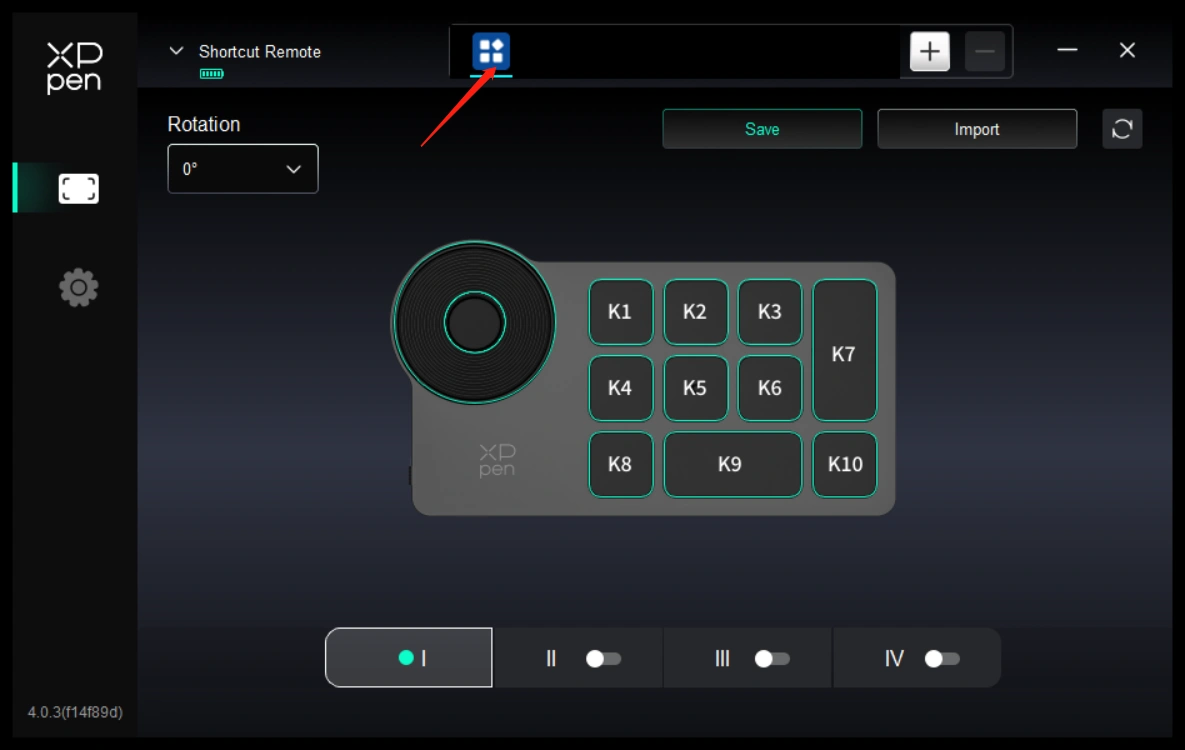
For settings or usage, see the drawing display settings above.
b) Roller
The button in the middle of the scroll wheel can be used to switch between the various function groups of the scroll wheel. The driver provides four groups of scroll wheel functions: zoom (default), scroll, brush, and rotate.
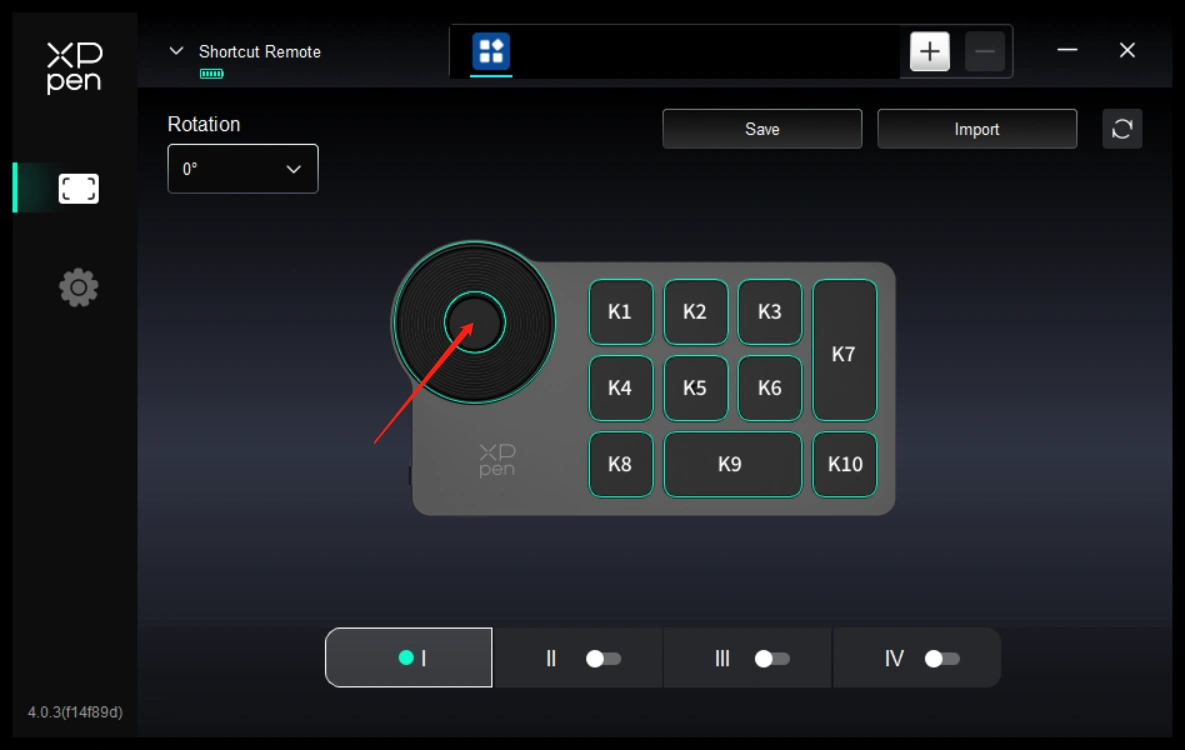
Customize:
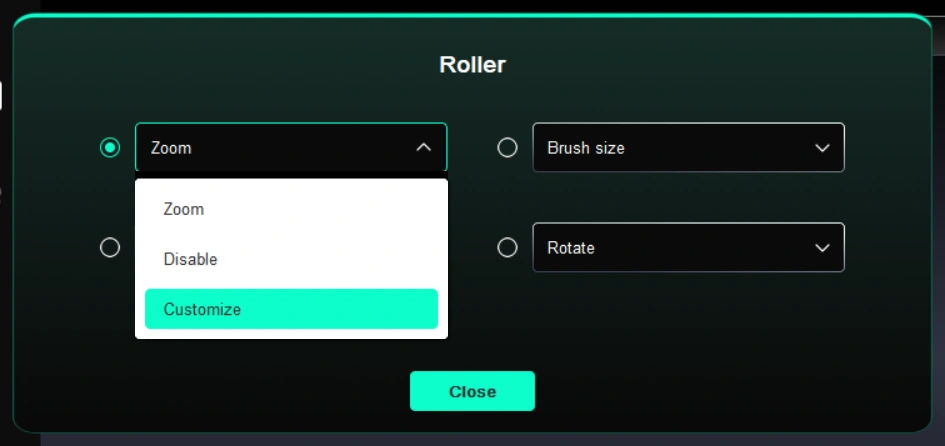
Click the position of the scroll wheel on the picture, select "Customize" in the preset function drop-down menu, and enter the key or key combination you want to set on the keyboard to customize the clockwise or counterclockwise function of the scroll wheel.
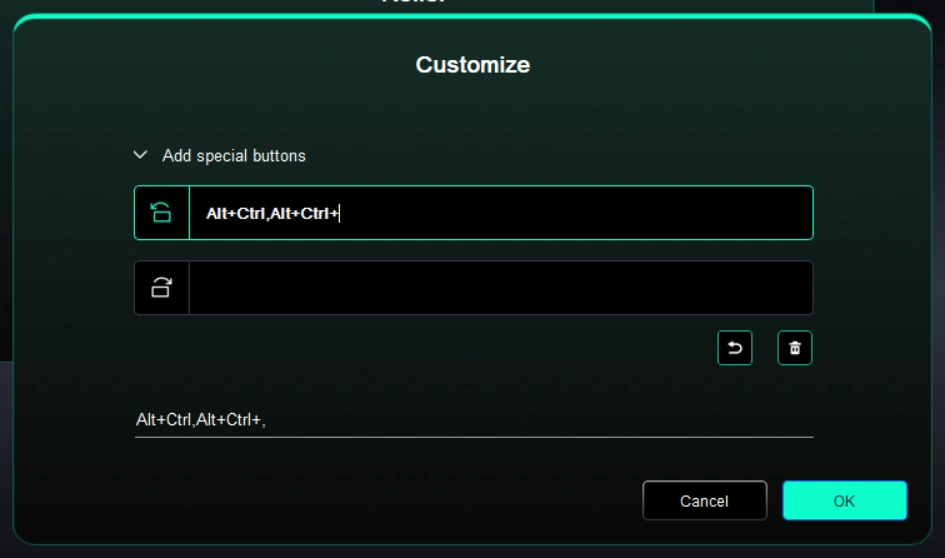
c) Save/Import
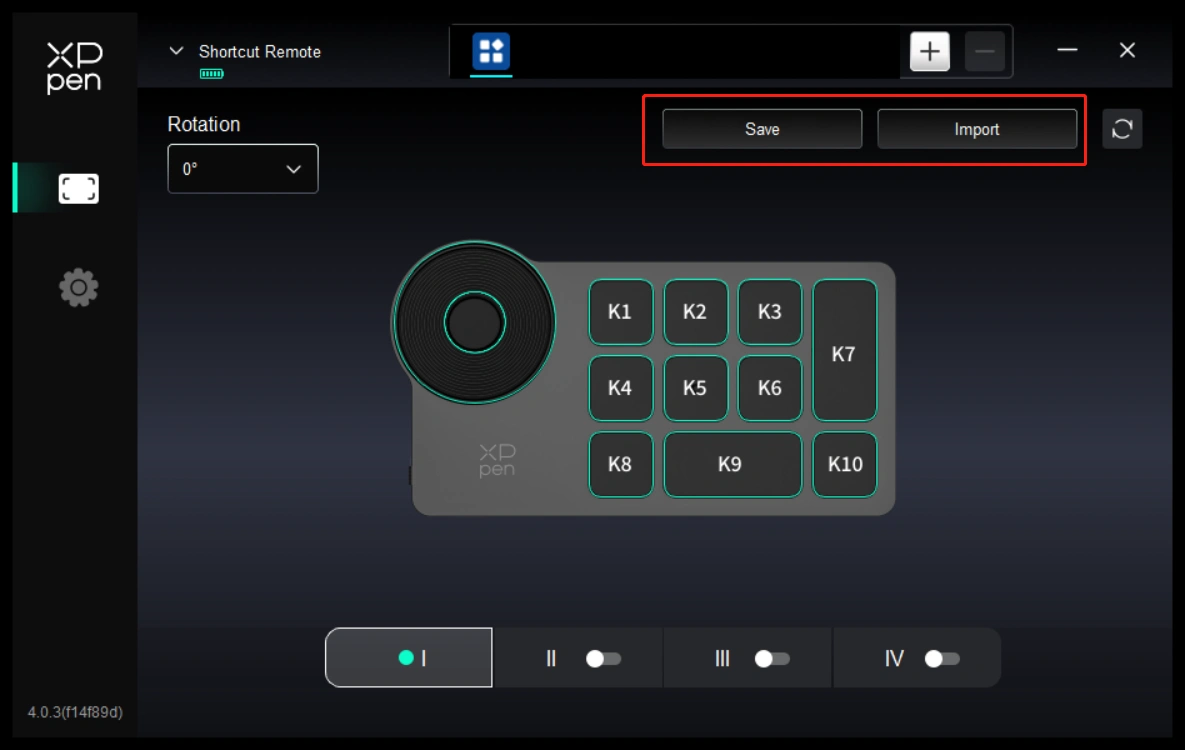
Import:
Import the configuration stored in the wireless shortcut keyboard to the currently selected application in the driver.
Save:
Save the configuration of the currently selected application in the driver to the wireless shortcut keyboard.
Note: Please use the "Import" and "Save" functions under wired connection. The "Import" and "Save" configurations do not include the rotation function and are only valid under the same system.
d) Shortcut Keys Groups
The driver provides four groups of shortcut keys. The first group of shortcut keys is used by default (cannot be turned off). The initial functions of other unenabled key groups are the same as the first group. Each group of keys can be customized with different functions. After enabling, you can switch between the enabled groups through "Key Group Switch" (the default is K1 key, which can be customized to other keys).
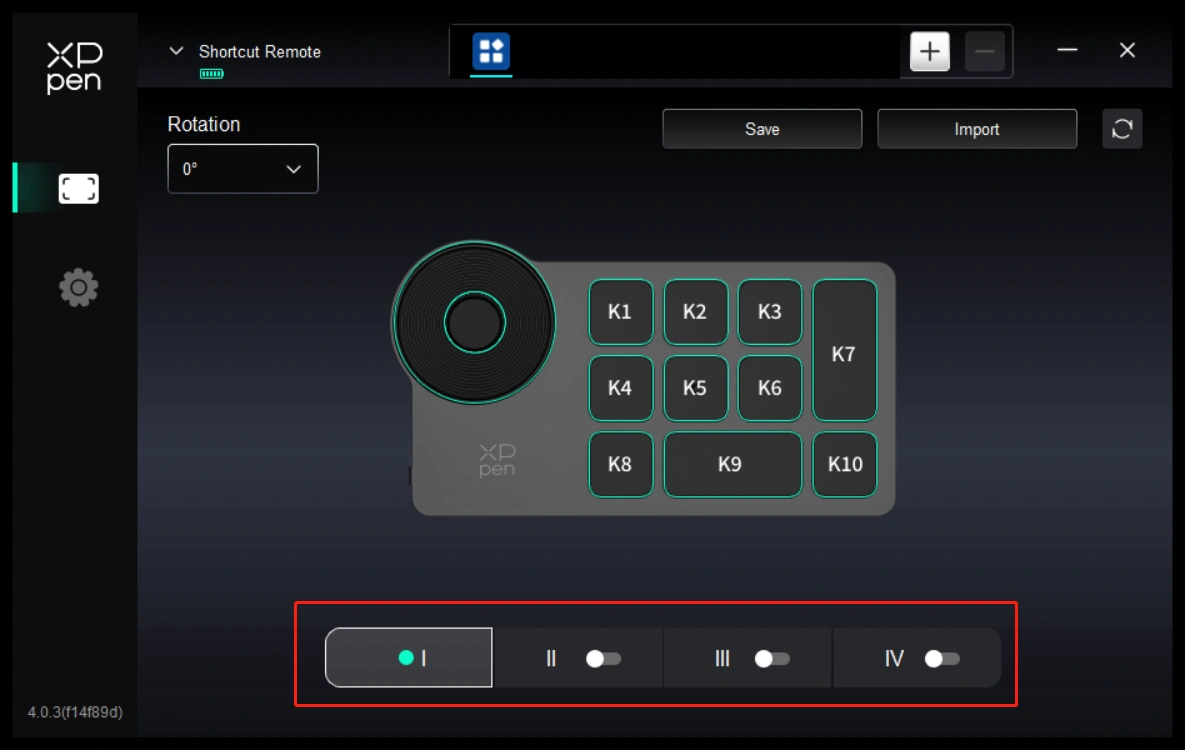
e) Customization
Click the corresponding button on the device image to customize its function; see above for settings or usage.
f) Set Preview
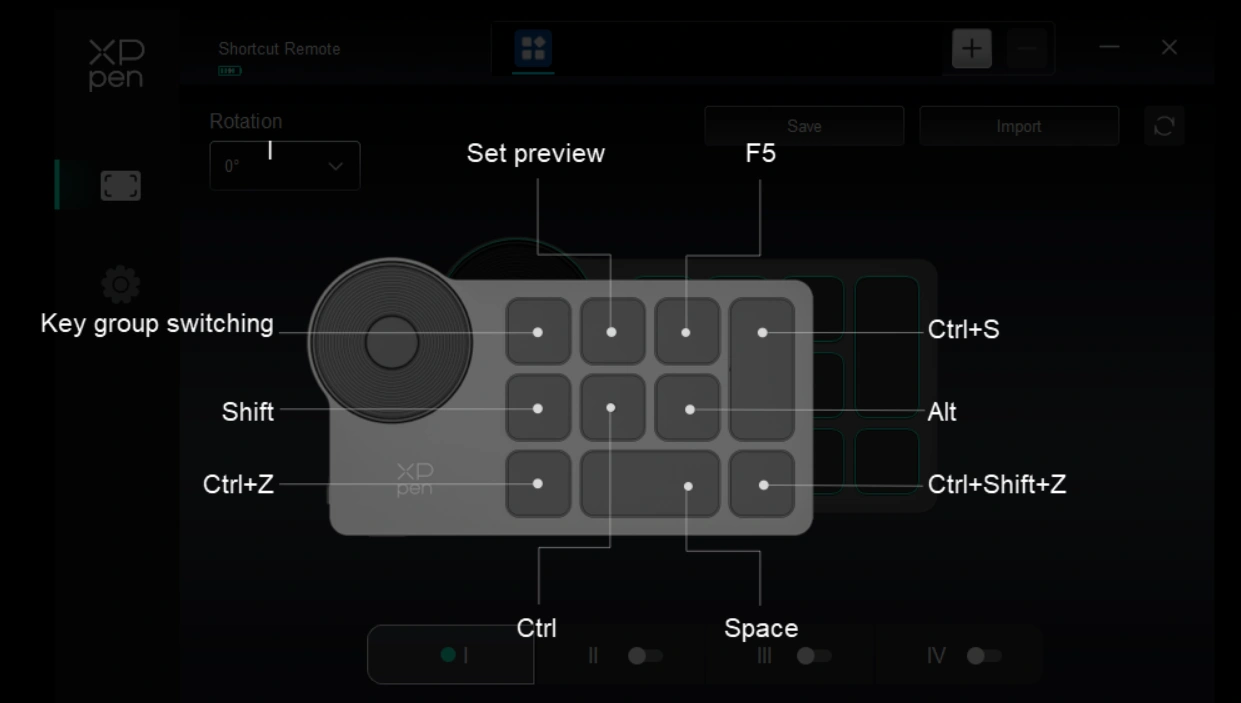
Press K2 of the shortcut remote to check the key group function in use. If you select an unenabled key group in the driver, the key functions in group I will be used by default. Click the close icon in the upper right corner to close the preview window.
g) Settings
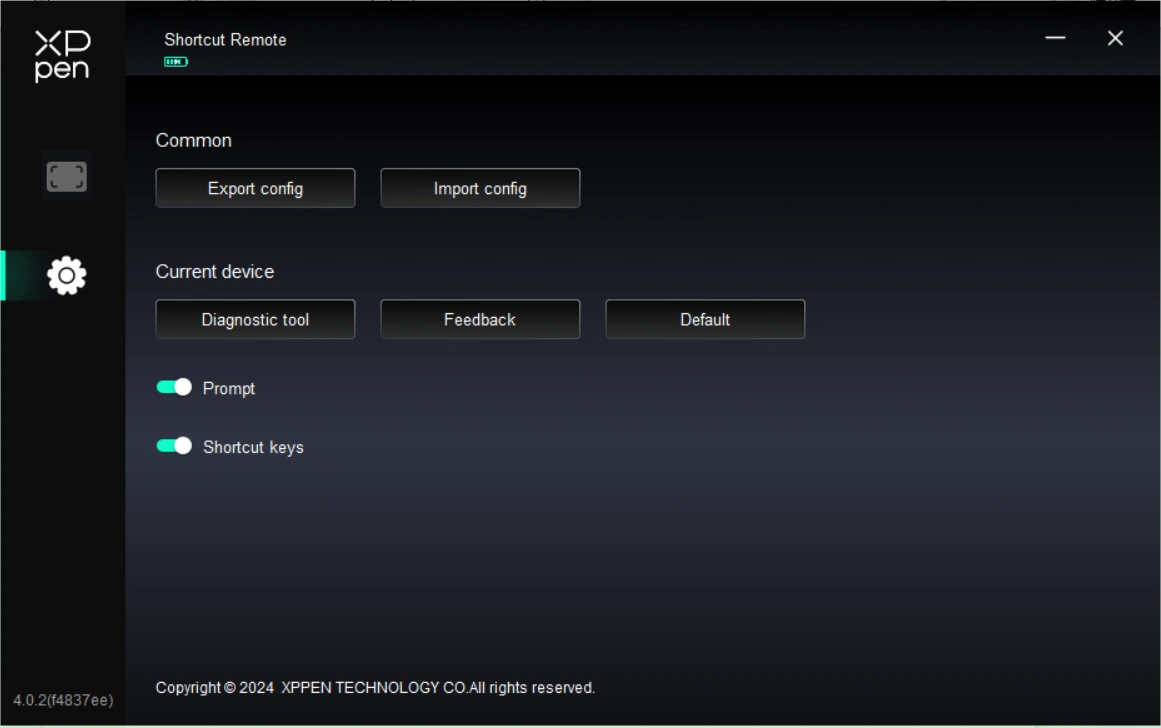
Import & Export Config:
Read or store the set values of the set functions using the import & export configuration method. This function is only supported under the same operating system.
Diagnostic tool:
When problems occur during the use of the driver, you can use the diagnostic tool.
Feedback:
If you have any questions or suggestions when using the driver, you can give us feedback through this page.
Prompt:
When turned off, the button prompt at the bottom of the screen will not be displayed when a button is pressed.
Shortcut keys:
When turned off, the functions of all buttons on the device will be disabled.
4.Driver Uninstallation
4.1 Windows
Go to Start -> Settings -> Apps -> Apps & Features, find "Pentablet" and then left click "Unload" as per prompts.
4.2 MacOS
Go to [Go]-> [Applications], find XPPen and then click "UninstallPenTablet" as per prompts.
4.3 Linux
Deb: Enter command “sudo dpkg -r XPPenLinux” and execute the command;
Rpm: Enter command “sudo rpm -e XPPenLinux” and execute the command;
Tag.gz: Unzip file. Enter command “sudo”. Drag uninstall.sh to the window and execute command.
1.No display or black screen on a drawing display.
1) Check if the device is connected to power supply properly;
2) Check if the cable is connected properly;
3) Check if the power indicator is blue. If not, check the cable and restart the device;
4) If the signal is unstable, check if the cable port is stable.
2.Computer fails to recognize the device.
1) Check if your computer's USB port works normally. If not, use another USB port.
3.Stylus does not work.
1) Make sure you are using the stylus that originally came with your device;
2) Make sure you installed the driver correctly, and check if the pen settings of the driver are normal.
4.The drawing software cannot sense the pen pressure while the cursor can move.
1) Check if the drawing software supports pen pressure;
2) Download the latest driver installation files from XPPen website, and check if the pen pressure is normal in the driver;
3) Before installing the driver, turn off your antivirus software and graphics software;
4) Uninstall drivers for other drawing displays before installation;
5) Restart your computer after the installation is completed;
6) If the pen pressure is normal in the driver (Windows: ensure Windows Ink is enabled in the pen settings of the driver), run the drawing software and test it again.
5.Cursor offsets.
1) Please use the driver to recalibrate.
2) If the cursor is seriously offset when you use the screen extension mode, please go to the driver---Drawing display---work area---screen, and confirm whether the default screen is selected as the Drawing display (Monitor 2).
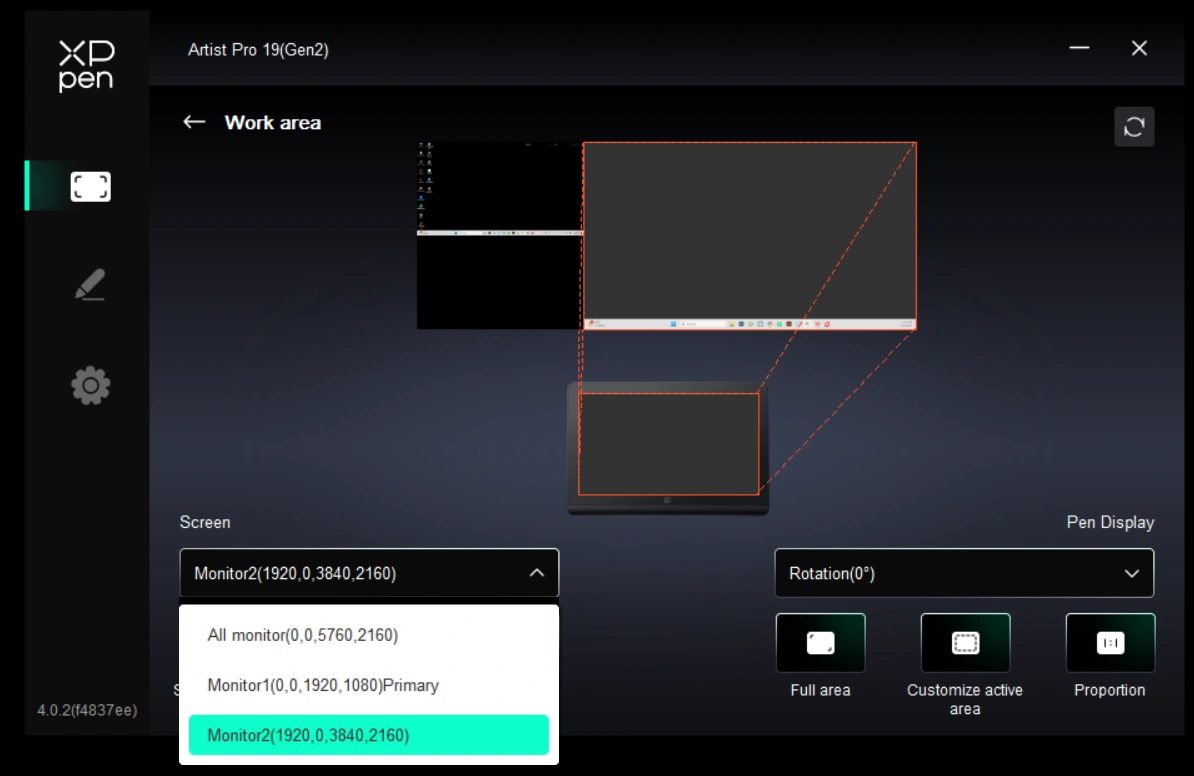
6.Line latency during drawing with the software.
Check if the computer configuration (CPU&GPU) meets the recommended configuration requirements for the drawing software installed, and optimize related functions via settings according to the FAQs posted on the official website of the drawing software.
7.The shortcut keys of the stylus are invalid.
1) Please confirm whether the distance between the nib of the stylus and the working area of the drawing display is higher than 10mm. If the distance is too high, the pen will not be activated and will have no function.
2) If you set the function of the pen shortcut key but find that it is invalid, please confirm whether the application you selected when using it is not the application shortcut key group you set.
* Refer to the figure below, the scroll wheel function in the PS interface is different from the scroll wheel function in the regular interface.
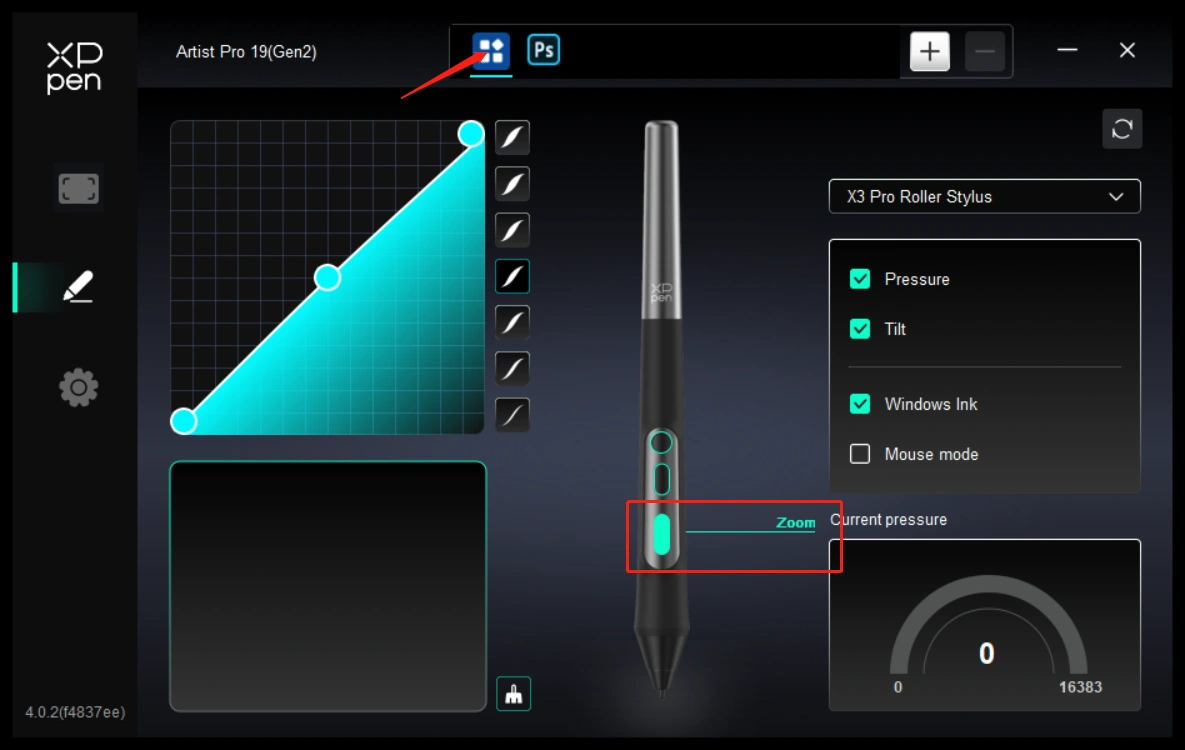
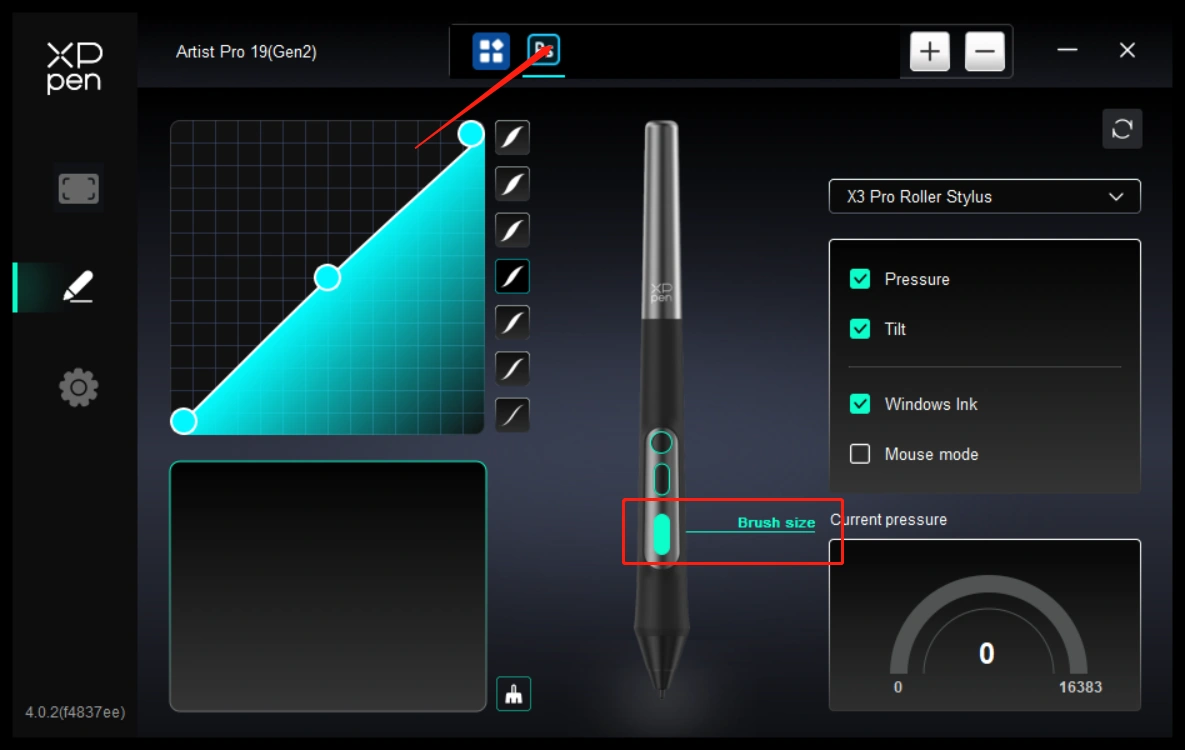
8.Your Windows computer cannot search for the “shortcut Remote”device via Bluetooth.
Step 1: Please open your computer system settings, select bluetooth & devices---->devices, and open the expansion options.
Step 2: Select the “Bluetooth devices discovery” option and change the setting to “Advanced” option.
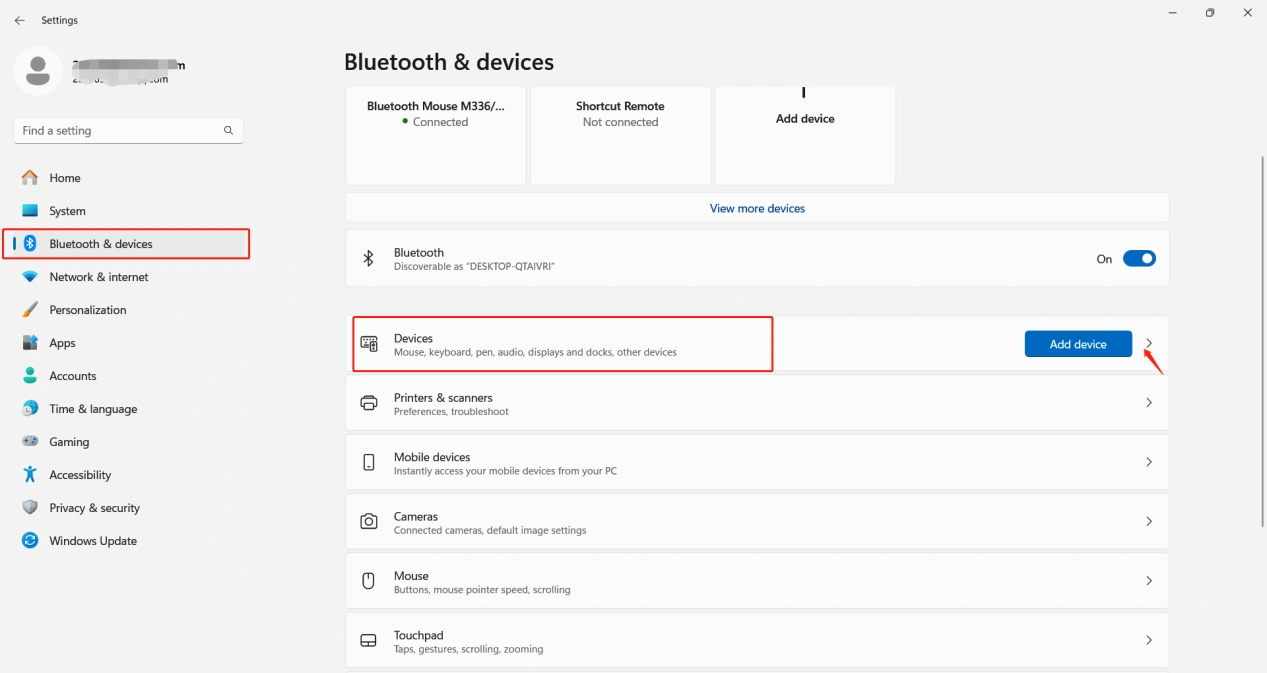
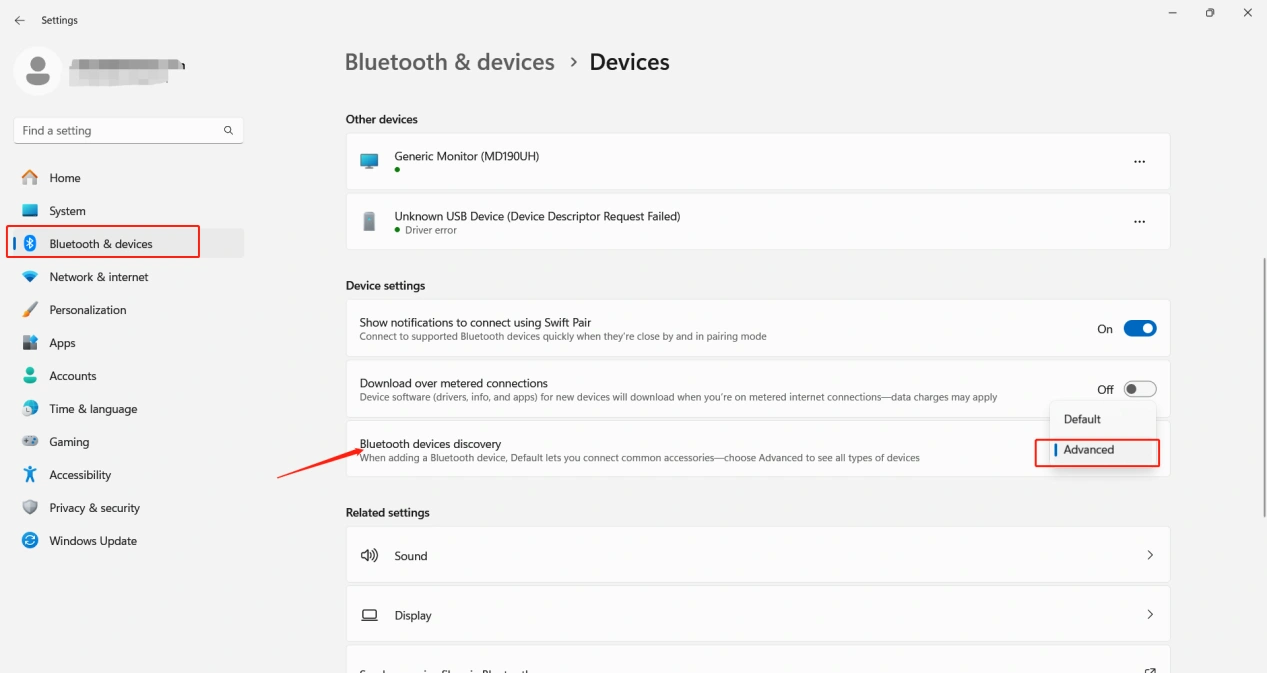
If you need any further assistance, please contact us at:
Website: https://www.xp-pen.com
Email: service@xp-pen.com
 PDF
PDF